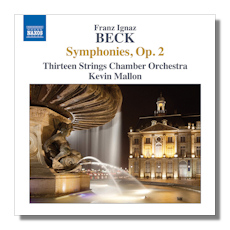
The Internet's Premier Classical Music Source
Related Links
- Beck Reviews
- Latest Reviews
- More Reviews
-
By Composer
-
Collections
DVD & Blu-ray
Books
Concert Reviews
Articles/Interviews
Software
Audio
Search Amazon
Recommended Links
Site News
 CD Review
CD Review
Franz Ignaz Beck

Symphonies
- Sinfonia in D Major, Op. 2 #1 (Callen 7)
- Sinfonia in G minor, Op. 2 #2 (Callen 8)
- Sinfonia in A Major, Op. 2 #3 (Callen 9)
- Sinfonia in E Flat Major, Op. 2 #4 (Callen 10)
- Sinfonia in D Major, Op. 2 #6 (Callen 12)
- Sinfonia in G Major, Op. 2 #5 (Callen 11)
Thirteen Strings Chamber Orchestra/Kevin Mallon
Naxos 8.573323 69:45
Further music of Beck on Naxos:
3 Symphonies w/ Op. 10 #2 & Op. 13 #1 (8.553790):
Amazon
- UK
- Germany
- Canada
- France
- Japan
- ArkivMusic
- CD Universe
- JPC
6 Symphonies Op. 1 #1-6 (8.554071):
Amazon
- UK
- Germany
- Canada
- France
- Japan
- ArkivMusic
- CD Universe
- JPC
4 Symphonies Op. 3 #1-4 (8.570799):
Amazon
- UK
- Germany
- Canada
- France
- Japan
- ArkivMusic
- CD Universe
- JPC
4 Symphonies Op. 4 #1-3 & Op. 3 #6 (8.573248):
Amazon
- UK
- Germany
- Canada
- France
- Japan
- ArkivMusic
- CD Universe
- JPC
6 Symphonies Op. 4 #4-6 & Op. 3 #5 (8.573249):
Amazon
- UK
- Germany
- Canada
- France
- Japan
- ArkivMusic
- CD Universe
- JPC
Franz Beck (1734-1809) wrote music in various genres, including operas and keyboard works, but he is best known for his twenty-four symphonies. He was an innovator and one of the most important composers of symphonies from the pre-Classical era. In this Naxos series of his symphonies there have been several previous volumes, and this new one offering the six symphonies comprising Op. 2 now finishes the set. One oddity about the ordering of the six works on this disc is that they appear sequentially for the first four symphonies, but then #6 is placed ahead of #5.
Fourteen of Beck's symphonies have three movements and are cast in a fast-slow-fast structure, modeled after the Italian sinfonia style. Five symphonies each from Opp. 3 and 4 have four movements, with a minuet as the third. These Op. 2 symphonies, all with three movements each, are mostly chipper and light works, but are more complex than they might at first appear. They feature quite colorful and brilliant orchestration and often divulge subtle contrapuntal writing. The music sometimes exhibits Beck's deft sense of humor in the scoring, too: try the Presto finale of the A major, #3, and notice the bouncy, sort of mocking bass retorts in the latter half. The works are scored mainly for strings, though #1 and #5 feature horns in the first and last movements. Harpsichord continuo is also employed in all six works here.
The obvious question about the music here is, are any of these symphonies masterpieces or outstanding in some way? Well, they are consistently engaging and could be described as minor masterworks whose appeal is their tunefulness, rhythmic vitality, contrapuntal adroitness and instrumental craftsmanship. You'll find few clouds and little angst in these symphonies: perhaps only the Adagio to #4 shows a few hints of darkness. One can safely assert that overall this music is ebullient and charming and will likely please listeners interested in music from the late Baroque and early Classical periods. On the negative side, some may find the works cut too closely from the same cloth, but I find enough variety and skill in them to warrant recommendation.
As for the performances, the Thirteen Strings Chamber Orchestra is excellent throughout, showing consistently spirited playing and a great sense of joy. Initially I was a little dubious about some of the presto finales (#3 and #6, for example), sensing the tempo chosen by conductor Kevin Mallon wasn't quite fast enough. The Allegro assai that opens #5, for example, sounds significantly faster than the just-concluded presto finale of #6. But the more I listened to the symphonies the more I found the pacing to be quite well judged within the context of each work. Overall, Mallon's interpretations are convincing, and he thus makes a fine case for Beck as an important symphonist. The sound reproduction by Naxos is very clear and well balanced and the notes by Allan Badley are informative.
Copyright © 2015, Robert Cummings





















